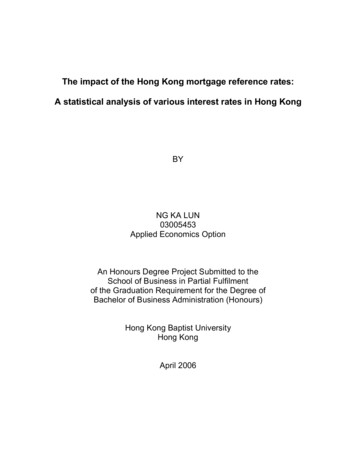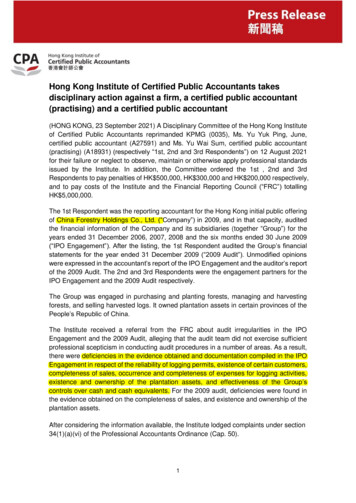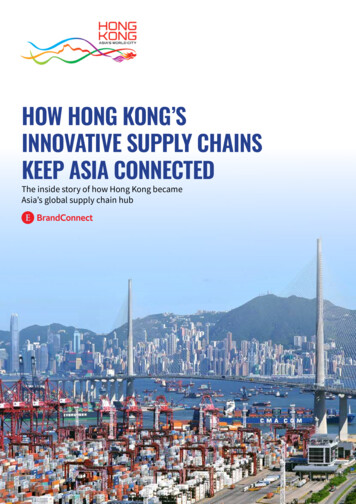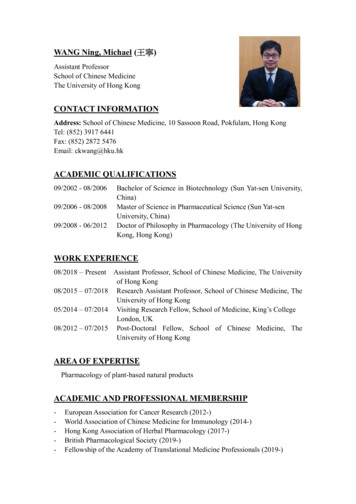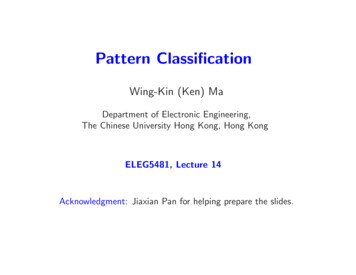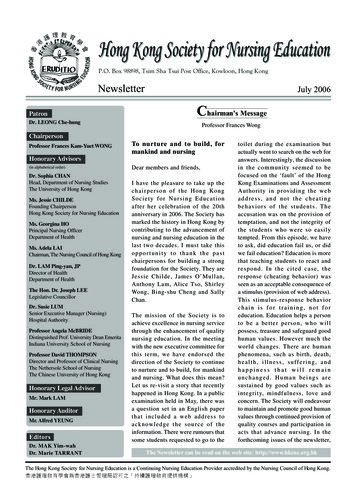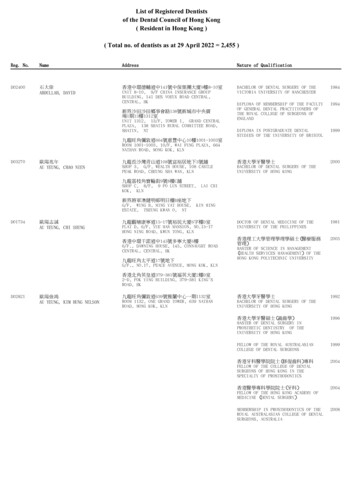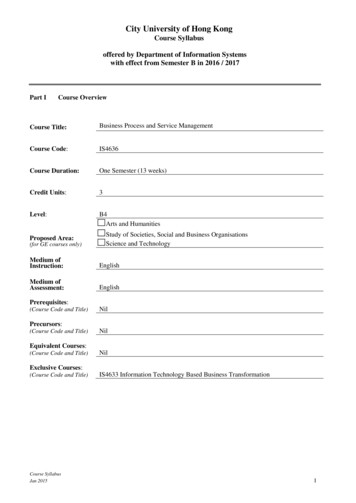
Transcription
City University of Hong KongCourse Syllabusoffered by Department of Information Systemswith effect from Semester A in 2017 / 2018Part ICourse OverviewCourse Title:Business Process and Service ManagementCourse Code:IS4636Course Duration:One Semester (13 weeks)Credit Units:3Level:B4Arts and HumanitiesProposed Area:(for GE courses only)Study of Societies, Social and Business OrganisationsScience and TechnologyMedium ofInstruction:EnglishMedium ofAssessment:EnglishPrerequisites:(Course Code and Title)NilPrecursors:(Course Code and Title)NilEquivalent Courses:(Course Code and Title)NilExclusive Courses:(Course Code and Title)Course SyllabusJun 2017IS4633 Information Technology Based Business Transformation1
Part II1.Course DetailsAbstract(A 150-word description about the course)This course is designed to introduce to students how business processes are managed using an enterprisewide scope, how this business process management (BPM) enables enterprises to create value in new andexciting ways, and how information technologies can be applied to master the contemporary challengesof process innovation, agility and sustainability. Students will learn the tools and technologies involvedin the different stages of the business process management life cycle.2.Course Intended Learning Outcomes (CILOs)(CILOs state what the student is expected to be able to do at the end of the course according to a givenstandard of overy-enrichedcurriculum relatedlearning outcomes(please tick whereappropriate)A1A2A3Describe how business process management principles are used20%to improve the efficiency and effectiveness of businessorganizations.Apply the concepts and models of business process management 2.25%to creatively demonstrate and analyze business processrequirements.Develop and design process-oriented business models 3.25%innovatively using the tools and notations of business processmanagement.Analyze concepts and methods of service-oriented architecture.4.10%Operate effectively in a collaborative environment and creatively5.10%demonstrate skills in team building and project management inbusiness process management.Communicate and present information effectively in formats6.10%adopted for business process management.* If weighting is assigned to CILOs, they should add up to 100%.100%#Please specify the alignment of CILOs to the Gateway Education Programme Intended Learning outcomes(PILOs) in Section A of Annex.1.A1:A2:A3:AttitudeDevelop an attitude of discovery/innovation/creativity, as demonstrated by students possessing a strongsense of curiosity, asking questions actively, challenging assumptions or engaging in inquiry together withteachers.AbilityDevelop the ability/skill needed to discover/innovate/create, as demonstrated by students possessing criticalthinking skills to assess ideas, acquiring research skills, synthesizing knowledge across disciplines orapplying academic knowledge to self-life problems.AccomplishmentsDemonstrate accomplishment of discovery/innovation/creativity through producing /constructing creativeworks/new artefacts, effective solutions to real-life problems or new processes.
3.Teaching and Learning Activities (TLAs)(TLAs designed to facilitate students’ achievement of the ject4.Brief DescriptionConcepts of business process management anddevelopment of process-centric models are explained.During laboratory sessions, the following activitiesare used to reinforce and practice of various businessprocess modelling techniques learnt in lectures: Exercises: Hands-on activities using a BPMS toolsuch as Intalio, SoftwareAG, Holosofx, BizzTalk,BizzDesigner, etc. as part of business processmodelling exercises. Discussion: Discussion on implications of variousconcepts learnt in lectures, and how they can beapplied to a typical BPM project. Presentations: Members of project team willmake presentation of their draft project work, andthe rest of the tutorial group and the instructorwill comment and offer suggestions forimprovements.Students would have to complete a group projectrequiring them to perform systems analysis activitiesin an information system in business sector. Thegroup project is divided into 4 parts that correspondto various systems analysis activities.CILO No.3 4 5 1 2 6Hours/week(if applicable)2 Hours/Week 1 Hour/Week Assessment Tasks/Activities (ATs)(ATs are designed to assess how well the students achieve the CILOs.)Assessment Tasks/ActivitiesContinuous Assessment: 50%AT1: Continuous Assessment in Lectures andLaboratoriesAttendance, Participation (In-class and OnlineDiscussions), Weekly Exercises.AT2: Project PresentationEach project team makes one presentation (about 30min) of their draft project work and the entire tutorialgroup will discuss and suggest improvements.Instructors may consider to split these presentationsinto 2 or 3 part presentations such as in Week 6 andWeek 12/13, etc.AT3: ProjectThe project includes (i) development of businessprocess models and (ii) business process deigns usingBPMN notations, (iii) development of servicerepositories to support the business process deignsand associated SOA models, and (iv) appropriateBAM and BPC.Part 1:5% Project ProposalPart 2:15% Project ReportExamination: 50% (duration: one 2-hour exam)AT4: Final ExaminationThis examination (open or closed-book) assesses theunderstanding of concepts taught in the course andtheir application.* The weightings should add up to 100%.#CILO No.1 2 3Weighting*4 5Remarks#620% 10% 20%50%100%Remark: Students must pass BOTH coursework and examination in order to get an overall pass in this course.
5.Assessment Rubrics(Grading of student achievements is based on student performance in assessment tasks/activities with thefollowing rubrics.)Assessment Task(AT)CriterionExcellent(A , A, A-)Good(B , B, B-)Fair(C , C, C-)Marginal(D)Failure(F)AT1: ContinuousAssessment inLectures andLaboratoriesAbility to describe how businessprocess management principles areused to improve the efficiency andeffectiveness of businessorganizations.Capability to apply the concepts andmodels of business processmanagement to creatively demonstrateand analyze business processrequirements.Capability to develop and designprocess-oriented business modelsinnovatively using the tools andnotations of business processmanagement.Capability to analyze concepts andmethods of teBasicNot asicNot asicNot asicAbility to describe how businessprocess management principles areused to improve the efficiency andeffectiveness of businessorganizations.Capability to apply the concepts andmodels of business processmanagement to creatively demonstrateand analyze business processrequirements.Capability to develop and designprocess-oriented business modelsinnovatively using the tools andnotations of business processmanagement.Capability to operate effectively in acollaborative environment andcreatively demonstrate skills in teambuilding and project management inbusiness process management.Ability to communicate and presentinformation effectively in formatsadopted for business processmanagement.Ability to describe how businessprocess management principles areused to improve the efficiency andeffectiveness of businessorganizations.Capability to apply the concepts andmodels of business processmanagement to creatively demonstrateand analyze business t evenreachingmarginallevelsNot asicNot asicNot asicNot asicHighSignificantModerateBasicNot evenreachingmarginallevelsNot asicAT2:ProjectPresentationAT3: ProjectNot evenreachingmarginallevels
AT4:FinalExaminationCapability to develop and designprocess-oriented business modelsinnovatively using the tools andnotations of business processmanagement.Capability to analyze concepts andmethods of teBasicNot asicCapability to operate effectively in acollaborative environment andcreatively demonstrate skills in teambuilding and project management inbusiness process management.Ability to communicate and presentinformation effectively in formatsadopted for business processmanagement.Ability to describe how businessprocess management principles areused to improve the efficiency andeffectiveness of businessorganizations.Capability to apply the concepts andmodels of business processmanagement to creatively demonstrateand analyze business processrequirements.Capability to develop and designprocess-oriented business modelsinnovatively using the tools andnotations of business processmanagement.Capability to analyze concepts andmethods of teBasicNot evenreachingmarginallevelsNot erateBasicNot asicNot asicNot evenreachingmarginallevelsNot evenreachingmarginallevelsNot evenreachingmarginallevelsPart III Other Information (more details can be provided separately in the teaching plan)1.Keyword Syllabus(An indication of the key topics of the course.)Roles of business process management in organizations; Relationship of business process management withsupply chain management; Customer relationship management and quality management; Business processmanagement life cycle; Business process modeling; Standards for business process management.2. Reading List2.1 Compulsory Readings(Compulsory readings can include books, book chapters, or journal/magazine articles.collections of e-books, e-journals available from the CityU Library.)1.2.3.There are alsoMathias Weske, Business Process Management – Concepts, Languages, Architectures, 2ndEdition. Springer, 2012. ISBN: 978-3-642-28615-5.Omar A. El Sawy, Redesigning Enterprise Processes for E-Business. McGraw-Hill, 2001.ISBN: 0-07-118113-X.Thomas Erl, Service-Oriented Architecture (SOA): Concepts, Technology and Design, PrenticeHall. 2005. ISBN: 9780-13-185858-9.
2.2 Additional Readings(Additional references for students to learn to expand their knowledge about the subject.)3.Jan vom Brocke, Michael Rosemann (Ed.), Handbook on Business Process Management 1: Introduction,Methods, and Information Systems, 2nd edition. Springer, 2015.Jim Sinur, James Odell, Peter Fingar, Business Process Management : The next wave : harnessingcomplexity with intelligent agents. Meghan-Kiffer Press, 2013.Roger Burlton, Business Process Management: Profiting From Process. ISBN: 0-672-32063-0.4.Steve Towers, Thrive! How to Succeed in the Age of the Customer.5.Steve Towers, In Search of BPM Excellence. ISBN: 0-929652-40-1.6.7.John Jeston and Johan Nelis, Business Process Management: Practical Guidelines to SuccessfulImplementations. ISBN: 0-7506-6912-7.Sandeep Arora, Business Process Management. Process is the Enterprise. ISBN: 1-4116-3117-X.8.Michael Havey, Essential Business Process Modelling.9.Martyn Ould, Business Process Management: A Rigorous Approach. ISBN: 1-902505-60-3.1.2.ISBN: 0-929652-41-X.ISBN: 0-596-00843-0.10. Debevoise, Neilson T. (2005), Business Process Management with a Business Rules Approach, BusinessKnowledge Architects. ISBN: 0-9769048-0-2.11. Rashid Khan, Business Process Management: A Practical Guide. ISBN: 0929652320.12. Rob Davis, Business Process Modelling With Aris: A Practical Guide. ISBN: 1852334347.13. David Chappell, Enterprise Service Bus: Theory in Practice.14. Dirk Krafzig, Karl Banke, Dirk Slama, Enterprise SOA: Service-Oriented Architecture Best Practices (TheCoad Series).15. James F. Chang, Business Process Management Systems. ISBN: 0-8493-2310-X.2.3 Online Resources:http://en.wikipedia.org/wiki/Business process managementhttp://en.wikipedia.org/wiki/Service Oriented ArchitectureWeb sites of the following organizations and media companies provide excellent on-line resources onBusiness Process Management. Association of BPM Professionals BPMG - Business Process Management Group BP Trends BPM Center BPM Prime Time BPM Institute BPM Enterprise BPM Basics Queensland University of Technology BPM Roundtablehttp://www.agilemodeling.com/
Sandeep Arora, Business Process Management. Process is the Enterprise. ISBN: 1-4116-3117-X. 8. Michael Havey, Essential Business Process Modelling. ISBN: -596-00843-. 9. Martyn Ould, Business Process Management: A Rigorous Approach. ISBN: 1-902505-60-3. 10. Debevoise, Neilson T. (2005), Business Process Management with a Business Rules .


